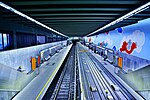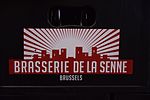Scheut
AnderlechtNeighbourhoods of BrusselsUse British English from July 2022

Scheut is a district of Anderlecht, a municipality of Brussels, Belgium. Located in the north of Anderlecht, it is bounded by the border with the municipality of Molenbeek-Saint-Jean to the north, the historical centre of Anderlecht to the south, the Birmingham district to the east, the Scheutveld district to the west and the semi-natural site of the Scheutbos to the north-west. The district is crossed by the Chaussée de Ninove/Ninoofsesteenweg running east–west and is served by the metro stations Aumale, Jacques Brel, and Gare de l'Ouest/Weststation (Brussels-West Station).
Excerpt from the Wikipedia article Scheut (License: CC BY-SA 3.0, Authors, Images).Scheut
Chaussée de Ninove - Ninoofse Steenweg,
Geographical coordinates (GPS) Address Website Nearby Places Show on map
Geographical coordinates (GPS)
| Latitude | Longitude |
|---|---|
| N 50.8475 ° | E 4.3075 ° |
Address
Scheut
Chaussée de Ninove - Ninoofse Steenweg
1070
Belgium
Open on Google Maps











